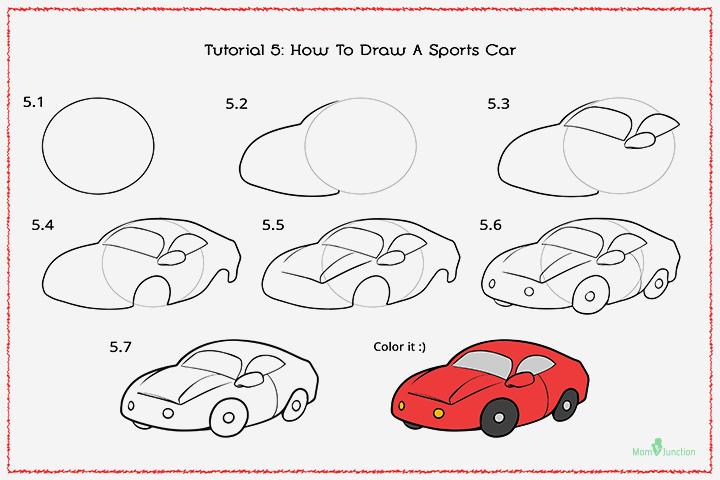In this beginner’s guide to car diagnostics, you’ll find an accurate step-by-step process for identifying and resolving issues with your car. With a simple step-by-step approach, this beginner’s guide to car diagnostics will help you accurately identify and fix issues with your car.
Whether it’s a strange noise, a warning light, or a performance problem, this guide will walk you through the process of diagnosing and resolving the issue, saving you time and money on unnecessary repairs. By following these steps, you’ll gain the confidence to tackle basic car diagnostics on your own, ensuring your vehicle runs smoothly and efficiently.
So let’s get started with this comprehensive guide to car diagnostics!

Credit: www.momjunction.com
Importance Of Car Diagnostics
Car diagnostics plays a crucial role in identifying and resolving potential issues with your vehicle. It provides step-by-step guidance for beginners to effectively troubleshoot and understand their car’s performance, ultimately saving time and money on repairs. Mastering car diagnostics empowers individuals to confidently maintain their vehicles for optimal functionality.
Preventative Maintenance
Regular car diagnostics help in preventing major issues by addressing problems early on.
Early Problem Detection
Car diagnostics enable early detection of potential problems, avoiding costly repairs later.
The Importance of Car Diagnostics lies in preventing major issues and detecting problems early to avoid costly repairs.
Regular car diagnostics help in maintaining vehicle performance and prolonging lifespan.
Basic Car Diagnostic Tools
When it comes to diagnosing car issues, having the right tools at your disposal is essential. Basic car diagnostic tools can save you time and money by allowing you to identify and fix problems on your own. In this article, we will explore two key tools that every beginner should have in their automotive toolkit: the OBD-II scanner and a multimeter.
Obd-ii Scanner
An OBD-II (On-Board Diagnostics) scanner is a must-have tool for diagnosing car issues. It is a portable device that plugs into your car’s OBD-II port, which is typically located under the dashboard. This scanner communicates with your car’s onboard computer to retrieve essential diagnostic information.
With an OBD-II scanner, you can quickly read fault codes and retrieve valuable data such as engine RPM, vehicle speed, coolant temperature, and more. This information helps pinpoint the problem area, allowing you to make more informed decisions when it comes to repairs.
Using an OBD-II scanner is straightforward. Simply plug the scanner into the OBD-II port, turn on the ignition, and follow the prompts on the scanner’s display. It will guide you through the process of retrieving and interpreting the diagnostic codes. Armed with this information, you can determine whether the issue is minor or requires professional intervention.
Multimeter
A multimeter is another essential tool for car diagnostics. It is a versatile device that measures various electrical parameters, including voltage, current, and resistance. A multimeter can help you identify electrical problems within your car’s system, such as a faulty battery, a faulty alternator, or a loose connection.
Using a multimeter involves connecting the device to different parts of the car’s electrical system and observing the readings. For example, you can test the voltage across the battery terminals to ensure it is within the normal range or measure the resistance across a specific circuit to check for continuity.
A multimeter is an invaluable tool not only for diagnosing car issues but also for troubleshooting household electrical problems. Its versatility and simplicity make it a must-have tool for any DIY enthusiast.
In conclusion, investing in basic car diagnostic tools like an OBD-II scanner and a multimeter is a wise decision for any beginner. These tools will empower you to tackle common car issues on your own, saving you time and money in the long run. With their help, you can diagnose problems accurately and make informed decisions about repairs. Start building your toolbox with these essential tools, and embark on your car diagnostic journey with confidence.
Common Car Diagnostic Procedures
Explore essential steps for beginner-friendly car diagnostics, covering common procedures to troubleshoot issues efficiently. Learn the step-by-step process to effectively diagnose and resolve car problems with ease. Complete guide for beginners looking to understand and perform necessary car diagnostic tasks.
When it comes to car diagnostics, there are a few common procedures that every beginner should be aware of. These procedures can help you understand the issues your car is facing and allow you to take the necessary steps for repairs or maintenance. In this guide, we will walk you through two essential car diagnostic procedures: Checking Error Codes and Testing Sensors and Components.
Checking Error Codes
One of the first steps in car diagnostics is to check the error codes that your vehicle’s onboard computer system is storing. These error codes can provide valuable information about the specific issues your car may be experiencing. To check the error codes, you will need an OBD-II scanner, which can be purchased or borrowed from an auto parts store or mechanic. Here’s how you can check the error codes:
- Locate the OBD-II port in your car, which is usually found underneath the dashboard on the driver’s side.
- Plug the OBD-II scanner into the port.
- Turn on the ignition, but do not start the engine.
- Follow the instructions provided by the scanner to retrieve the error codes.
- Once you have the error codes, you can look them up online or consult with a mechanic to determine the cause of the problem.
Testing Sensors And Components
Another crucial step in car diagnostics is testing the sensors and components that play a role in the functioning of your vehicle. These sensors and components can include the oxygen sensor, mass airflow sensor, throttle position sensor, and more. By testing these components, you can identify any faulty parts that may be causing performance issues. Follow these steps to test sensors and components:
- Refer to your vehicle’s service manual to determine the location of the specific sensor or component you want to test.
- Disconnect the electrical connection to the sensor or component.
- Using a multimeter, set it to the appropriate setting and check for continuity or resistance as per the service manual’s instructions.
- Compare the readings with the specifications provided in the service manual.
- If the readings deviate significantly from the specifications, you may need to replace the sensor or component.
By familiarizing yourself with these common car diagnostic procedures, you can gain a better understanding of your vehicle’s issues and take the necessary steps to resolve them. Remember, if you are unsure or uncomfortable performing these procedures yourself, it is always best to consult with a professional mechanic.
Interpreting Diagnostic Results
Interpreting diagnostic results is crucial in understanding the health of your car and identifying potential issues. By analyzing error codes and sensor readings, you can pinpoint problems and take appropriate action to ensure your vehicle runs smoothly.
Understanding Error Codes
Error codes provide valuable insights into specific problems affecting your car. These codes are generated when the vehicle’s computer detects an issue, such as a malfunctioning component or system. Refer to the car’s service manual or online resources to decipher the error codes and identify the exact nature of the problem.
Analyzing Sensor Readings
Sensor readings offer real-time data on various aspects of your car, such as engine performance and emission levels. Analyzing these readings can help you detect anomalies and potential issues early on. Keep an eye on sensor values like oxygen levels and temperature to ensure optimal vehicle operation.
Simple Diy Diagnostic Fixes
In this section, we’ll cover some simple DIY diagnostic fixes that can help you troubleshoot common car issues on your own. These basic maintenance tasks can save you time and money while keeping your vehicle running smoothly.
Replacing Spark Plugs
Spark plugs play a crucial role in your car’s engine performance. Over time, they can become worn or fouled, leading to issues such as rough idling, poor acceleration, and decreased fuel efficiency. Replacing spark plugs is a straightforward task that can be completed with basic tools. Here’s a step-by-step guide to tackle this essential maintenance job:
- Gather the necessary tools: new spark plugs, a socket wrench, and a spark plug socket
- Locate the spark plugs: refer to your car’s manual to find the location of the spark plugs in the engine bay
- Remove the old spark plugs: carefully unscrew them using the socket wrench and spark plug socket
- Install the new spark plugs: use the spark plug socket to securely place the new spark plugs into the engine
- Tighten the spark plugs: ensure they are snug, but be cautious not to over-tighten them
Cleaning Mass Air Flow Sensor
The mass air flow (MAF) sensor measures the amount of air entering the engine, playing a critical role in fuel efficiency and engine performance. Over time, the MAF sensor can become dirty or contaminated, leading to issues such as rough idling and engine hesitation. Cleaning the MAF sensor is a simple task that can sometimes resolve these problems. Here’s how to clean the MAF sensor:
- Locate the MAF sensor: consult your car’s manual to find the exact location of the MAF sensor in the engine bay
- Disconnect the MAF sensor: carefully remove the electrical connector leading to the sensor
- Clean the sensor: use a specialized MAF sensor cleaner to gently spray and clean the delicate components
- Allow the sensor to dry: ensure the sensor is completely dry before reinstallation
- Reconnect the MAF sensor: carefully plug the electrical connector back into the sensor
Credit: www.momjunction.com

Credit: www.amazon.com
Frequently Asked Questions Of Beginner’s Guide: Step-by-step Car Diagnostics
What Are The 7 Steps To Automotive Diagnoses?
The 7 steps to automotive diagnosis include: 1. Gathering information about the problem. 2. Conducting a visual inspection of the vehicle. 3. Performing a computerized diagnostic scan. 4. Checking and testing the various components and systems. 5. Analyzing and interpreting the data collected.
6. Identifying the root cause of the problem. 7. Providing a diagnosis and recommending the necessary repairs or solutions.
What Is The First Step In Diagnosing A Vehicle?
The first step in diagnosing a vehicle is to perform a comprehensive inspection of its components, systems, and overall condition. This involves checking for any visible issues or abnormalities, as well as using diagnostic tools to identify and analyze any potential problems.
What Are The Basic Steps In The Diagnostic Process?
The basic steps in the diagnostic process include patient history, physical exam, testing, analysis, and treatment plan development.
How Do You Learn To Diagnose Car Problems?
Learning to diagnose car problems involves studying automotive systems, using diagnostic tools, and understanding common issues. Enrolling in a formal training program or seeking guidance from experienced professionals can also be beneficial. Regular practice and hands-on experience can improve diagnostic skills over time.
Conclusion
Understanding the basics of car diagnostics enables you to tackle common issues effectively. With this guide, you can navigate through troubleshooting steps with confidence. Remember to follow manufacturer’s guidelines and use diagnostic tools wisely for optimal results. Empower yourself to troubleshoot and maintain your vehicle effortlessly.
Optimizing your car’s performance is just a diagnostic check away.
